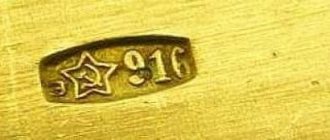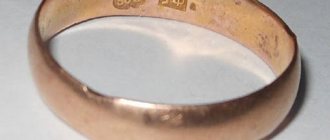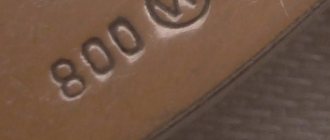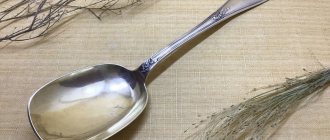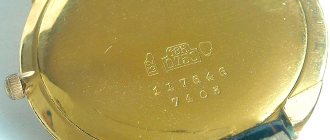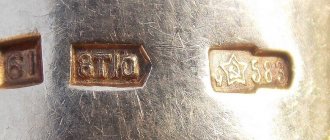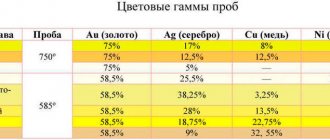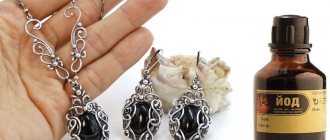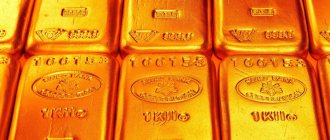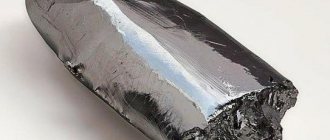Today, many types of jewelry are produced from alloys with different compositions. They differ in sample. Modern options: 375, 500, 585, etc. Among them, the option that complied with the USSR standard - 583 gold standard - is no longer mentioned. Despite the gradual transition to other types of products, many still have jewelry from those times.
Such jewelry has its advantages and disadvantages. But the transition from the most common standard in the post-Soviet countries (583) to European standards for determining quality (585) was associated not with the characteristics of the precious metal, but with a change in the structure of the state, which required transformations in all areas, including jewelry.
USSR gold - 583 standard with an asterisk, what is the value
A hallmark is a numerical designation that a precious metal receives when determining the content of its components. Products 583 corresponded to the gold standard adopted in the USSR. The test was introduced during the transition to the metric testing system (in 1927). This facilitated production - most of the products had a similar composition, the decorations differed mainly in shade.
The main share of the alloy was gold (58.3%), the rest was alloy.
The famous Soviet standard - 583 gold.
Today you can find jewelry with an asterisk. They do not have a modern hallmark. But on the back of the products there is still a mark - a five-pointed star, with a hammer and sickle on the inside. This is what a Soviet 583 ring looks like. Don't immediately suspect a fake.
Products of this type are authentic, but somewhat outdated. Their main value lies in their characteristics. If there is a star on a ring or bracelet, it means that the metal is durable, not prone to darkening, lasts a long time, and does not lose its attractiveness.
How is it different from 585 gold?
These alloys differ in their content of precious metal, although only by two tenths of a percent. Considering the remedium (permissible deviation) of 0.3%, the difference can either increase or disappear, so the difference is negligible. There is no noticeable difference in the strength and durability of identical gold products of 585 and 583 samples, but their cost will vary.
583 or 585 – which is better?
In fact, sample 583 has lost its relevance. Gold alloys of this purity are no longer used in jewelry making. But some collectors are ready to offer higher prices for Soviet-era items, as for antiques.
My personal example is the opposite: when I handed over a 583-carat piece to a jeweler, he was very reluctant to accept such jewelry from me.
Soviet gold alloy colors
The difference between metals of the same category (583 gold) is significant, and it lies mainly in shades:
| Gold Alloy Color | Ligature content,% |
| Yellow | Cu 33.7 + Ag 8 |
| Green | Cu 11.7 + Ag 30 |
| Red | Cu 41.7 |
| Pink | Cu 32 + Ag 9.7 |
| Pink-yellow | Cu 22.7 + Ag 19 |
| Citric | Cu 11.5 + Ag 30.2 |
| White | Cu 3 + Ag 11 + Ni 25 + Zn 2.7 |
The amount of gold in the table is the same for each case – 58.3%.
Gold rings 583 samples
Scope of application of this alloy
Due to its properties - strength, ductility, easy soldering, scratch resistance, this gold alloy has found wide application in the manufacture of jewelry intended for everyday use. Our grandmothers still wear, without removing, their favorite pendants, earrings or wedding rings, which are decorated with a sample with a star.
Brand with a star, what it looks like, history of origin, what it means
Today, 583 gold is not used for mass production of jewelry, otherwise the corresponding sample could be found on it. Its main distinguishing mark is the star-shaped mark. Previously (until 1958) they used a different marking - the head of a worker with a hammer. The sample changed, after which it quickly became recognizable.
This is a star containing a hammer and sickle, which means it belongs to the Soviet Union, since inside the sample there are the main elements of the coat of arms.
At the same time, the designation of the assay office has also changed. Cyrillic letters began to appear on jewelry of those times.
The secret of the popularity of the audition with a star
Soviet 583 gold, like many other things of that era, was distinguished by its monumentality and was created to last for many years. This also applied to jewelry. Earrings, chains, rings, bracelets, watches, jewelry sets, etc. - they complied with GOST, the production process was not disrupted.
The percentage of defects was minimal, almost approaching zero. In addition, gold 583 had a considerable number of advantages. The main advantage was considered to be the long service life of the products. This is due to its high hardness and resistance to mechanical stress.
As a result, earrings and rings did not change their appearance. This can be said about products of different colors - white, yellow, etc. But the numerous advantages would not be of much importance if the price were high. The cost of a troy ounce of gold during the Soviet Union was $200-300.
Is it true that Soviet gold is better?
The most common standard of Soviet gold is 583, the color is red. USSR jewelry is of good quality, made, as they say, to last: without unnecessary grace, but really strong, always quite weighty, with reliable stone settings. In comparison with the low-grade jewelry that came after them from Turkey, the Italian “puffery”, they truly seem monumental. Is Soviet gold really better than modern gold? It depends at what point you compare!
Gold ring with large emerald and diamonds 911025I
Design
If we talk about design, it was not very diverse in the USSR. In 1983, about 500 models of rings with inserts were produced throughout the Soviet Union, and today the Diva assortment alone amounts to 1000 models. Exclusives were created to order, each factory model was replicated in batches of thousands.
Workmanship
Everything Soviet is associated with high reliability, be it earrings or a tank. Today, many people complain that rings bend and earrings break. It should be noted that this is also the fault of the buyer with his desire to save money. The weight of a Soviet wedding ring of 583 standard with a width of 5 mm was about 5 g, but today wedding rings with the same width weighing 1.5 g are offered, i.e. with a very thin wall. When choosing lightweight jewelry, the buyer should be prepared for the fact that they are not intended for regular wear!
Inserts
Not every person from the Soviet Union could buy jewelry with natural stones. Of course, Soviet diamond rings were produced, but they were sold “through connections.” Almost all inserts in jewelry from the times of the USSR are artificial stones, so it’s hard to call them family jewels in the full sense of the word.
Ergonomics
Many models were not particularly comfortable. The fit of wedding rings is straight, for bands wider than 4mm this means cutting the edges into the skin. The earrings are heavy, sometimes with a thickened square pin for reliability.
Sample of Soviet gold
The percentage of precious metal from the USSR is equal to or slightly lower than in modern Russian gold. The composition of alloying additives may differ slightly, but for red gold it is still the same copper and silver; we talked about this in more detail in the article “What are the hallmarks of gold.” Talking about some incredible quality of Soviet-era gold in comparison with modern Russian gold is more about nostalgia than reality.
The reason for changing the sample to 585. Which is better. The first GOST for gold
First of all, it is necessary to understand where the number 583 came from, if other assay systems used alloys with a similar composition, but a different designation - 585. In this case, translation between systems plays a key role. Calculation features:
- when the karat system is taken as a basis, the precious metal content in the alloy is taken into account, the conventional unit is 1/24 part (where 24 is pure gold), if we consider the features of hallmarking based on 14 carat metal, it turns out that such an alloy contains 14 parts of pure gold, due to simple calculations, the content of precious metal is determined - 583.33333;
- if the resulting value is converted back into the carat system, it turns out that the amount of gold will be less (13.9, not 14), this error is the main reason why the international community refused to recognize this type of metal.
The peculiarity of this situation is that the calculations take into account the permissible deviation of 0.3% (remedium). As a result, 583 samples appeared on the territory of the USSR. For this purpose, the value corresponding to the amount of gold in 1000 g of alloy was rounded down.
For comparison, in other countries where the metric system was in effect, rounding occurred upward.
The transition to European standards became possible after the collapse of the USSR. At the same time, the 583 standard lost its relevance, and a transition to 585 occurred. This was prompted by the situation on the foreign market: Soviet gold was rejected, it was accepted at the price of scrap. This was explained by the discrepancy between the samples.
Soviet-era gold earrings of 585 standard
When the transition from gold standard 583 to 585 occurred, the remedium also had to be taken into account, since it could have been provided for in the direction of increase. Because of this, when gold content was determined, a metal containing 58.9% of the precious component could be assayed, but jewelry with 58% could not.
The importance of accounting for remedium increases when the count goes into kilograms. For example, the fluctuation between the amount of gold 586 and 580 kg is significant. As a result, already in 1994, the 583 sample was changed to 585. However, the corresponding transformations were not made in the marking system. The old samples were still being stamped. Only closer to 2000 did stamps appear on all products that corresponded to the characteristics of the metal.
To regulate the production process of gold alloy jewelry, regulatory documents are taken as a basis. Today, the composition of alloys is determined by GOST 30649-99. Previously, among the first regulatory documents was GOST 17234-71. It contains calculations to determine the gold content, including in the composition of the 583 alloy.
What kind of sample is this
Alloys are used to make jewelry. Their value is determined by the quantitative ratio of pure gold to the remaining components (ligature) and is expressed in the sample, which is applied to the finished product by branding.
In 1927, in connection with the transition of the sampling system from spool (as in Tsarist Russia) to metric, sample 583 was approved. In recalculation, it corresponds to the previous value of 56 spools. A stamp with the number 583 indicates that in one kilogram of this alloy there are 583 grams - gold in chemically pure form.
Why was the 583 sample replaced with 585
After the collapse of the USSR, in connection with the entry of a new country into world markets, it became necessary to bring the quality of goods into line with international standards. The international community refused to recognize 583 gold, since when converted from the metric to the carat system, the final value is 13.9 carats instead of the required 14.
In addition, the permissible deviation from the norm (remedium) is +/- 0.3%. This meant that the chemically pure gold content could range from 586 to 580 grams per kilogram. Therefore, in accordance with market requirements, a new standard was established in 1994 - 585 alloy.
Composition and properties
In the industrial production of the 583 alloy, a three-component composition with high strength, ductility and ease of use was used, including 33.5% copper and 8% silver. It was the high copper content that gave the metal a noble color with a distinct red tint - such gold was called red gold by analogy with the royal chervonets, which were minted from an alloy of gold and copper and had a similar color.
Strength
Using chemically pure precious metal to make jewelry is impractical, as it is too soft a material. Any thing made of 999 gold will very quickly lose its attractiveness and shine.
In the form of an alloy, gold has much greater strength and resistance to deformation and wear. With proper care, such a piece of jewelry can be passed down from generation to generation as a family heirloom without losing its presentability.
Shades and alloys
The color of the alloy changed depending on the proportions and what metals were contained in the alloy - from greenish-yellow to pink, so products with the same purity could have different shades. Based on this property, jewelers willingly experimented with the composition of the ligature in order to achieve especially successful color schemes and properties of the finished product. The table below lists the main types of gold and their shades.
Alloy shade chart
| Color | Ligature, % | Notes |
| Reddish | Silver – 8 Copper – 33.5 | Red gold |
| Pink | Silver – 9 Copper – 32 | |
| Yellow | Silver – 18.7 Copper – 22.7 | |
| Citric | Silver – 30 Copper – 11.5 | |
| White | Silver – 10 Copper – 3 Nickel – 25 Zinc – 3.5 | Mainly used as inserts in products with stones |
Brand
Simultaneously with the transition to the metric testing system for precious metals, the approved type of mark also changed. The woman's head in the kokoshnik was replaced with the profile of a worker with a hammer. On June 1, 1958, a five-pointed Soviet star appeared on the stamp. In 1994, the circle was closed and today modern jewelry is again branded with a female profile with a crown.
Expert opinion
Vsevolod Kozlovsky
6 years in jewelry making. Knows everything about samples and can identify a fake in 12 seconds
A brand is a way to protect an expensive item from counterfeits. A handmade mark, as a rule, was noticeably different in quality from the marks that were put on gold by the experts of the assay office. It consisted of the letter designation of the department that carried out the inspection, an image of a star and a sample.
How many carats are in this sample?
Any sampling system shows how many parts of a chemically pure metal the alloy contains; the only difference is in the units of measurement - kilogram, pound or carat. You can convert the sample value from the metric system to carat or spool using a conversion table.
| Zolotnikovaya | Carat | Metric |
| 96 | 24 | 999,9 |
| 92 | 23 | 958 |
| 91 | Not applicable | 947 |
| 88 | 22 | 916 |
| 84 | 21 | 875 |
| 72 | 18 | 750 |
| 56 | 13,9 | 583 |
| — | 14 | 585 |
| 48 | 12 | 500 |
| 36 | 9 | 375 |
Table: compare alloys, which is better: 583 or 585
There is a difference between metals containing 58.3% and 58.5% gold, but it is insignificant. Main features:
| Options | Alloys | |
| 583 | 585 | |
| Non-compliance with the standard according to the carat system – 14 carats | 0,01 | — |
| Remedium | 3 | 5 |
| Amount of gold | The metals are on the same level, despite the difference in gold content. The reason is the remedium. In nickel-based 585 alloys, the tolerance from the standard is greater, so the amount of pure gold contained in the alloy may actually be less | |
| Color | Red | White yellow |
| Wear resistance | High | Moderate |
Soviet era gold ring 585
Does gold darken
Gold jewelry of 583 and 585 samples, made without violating technology and not exposed to aggressive environments, does not darken. Jewelry should be protected from iodine, mercury, and liquids with a high content of acetone and chlorine. If such a situation occurs and the gold has oxidized for no apparent reason, then this is a reason to take it for inspection.
Why do gold items turn your fingers black?
If the issue is not the poor quality of the ring, then there may be several reasons:
- This is a new item, and it is quite possible that there are residues of polishing paste on it, which caused the darkening on the leather. Over time, the problem will disappear on its own.
- Using hand cosmetics whose components lead to metal oxidation. In this case, changing the cream or avoiding contact of the product used with the rings will help.
Appearance of gold streaks
The sudden appearance of marks from a gold ring on your hand may be a signal of changes in the body. There are no facts confirming the presence of the disease in such a situation, but if suddenly, for no apparent reason, your favorite ring began to leave a noticeable mark, then why not get examined. It definitely won't get any worse.
The use of 583 gold then and today: pros and cons
If previously various jewelry (women's, men's) were made from the precious metal containing 58.3% gold, today it is not used to create jewelry. But there is an opportunity to buy/sell them. Moreover, most often the jewelry was previously used (second-hand).
Previously, the material containing 58.3% gold was relatively inexpensive, was durable, and therefore was in demand. Today, in order to control the cost of precious products, standards are being changed. If it was once customary to purchase wide rings of great thickness, the weight of which exceeds 5 grams, today the values of all the main parameters have been simplified.
For example, the metal has become thinner and lasts less. In addition, the average weight of the product is 2.5 g. If desired, you can purchase heavier jewelry, but the price will be higher. There are rings weighing 4.9 g, 3.72 g, 9.52 g, etc. Advantages of 583 gold that were relevant earlier:
- attractive appearance;
- unlimited service life;
- low price;
- high quality.
Soviet jewelry
The disadvantages of operation include the small number of design options. Standard designs were often used. Today, such products are still popular among connoisseurs. This is due to the advantages of gold 583, taking into account modern realities:
- long service;
- Each product of that time has its own history;
- minimal care.
Where was the 583 sample used?
The test was used for almost all types of jewelry. This includes bracelets, pendants, chains, and rings. Large rings were especially popular; they could weigh more than some bracelets. If you find them now, their appearance will be almost identical to how they were when you purchased them.
At the moment, this sample can be found rarely, since it is not accepted internationally and is considered a second-class alloy.
Now people are well aware of this, and in order not to risk their reputation, they do not buy such jewelry.
But at the same time, gold is popular in certain circles. Many people order custom jewelry made from this gold. Things made in the old style are especially beautiful. An alloy is used for them, which will give a reddish tint.
At the moment, if the sample is used, then for the following items:
- wrist watch;
- accessories;
- pens;
- keychains;
- earrings for piercing;
- souvenirs;
- products for decoration.
Stones with 583 gold
Some products were in particular demand:
- with corundum - a pink, reddish stone, valued especially highly today;
- ring with a cabochon stone (made using a special processing technique);
- products with ruby;
- alexandrite;
- amber;
- pearls;
- diamond.
The most popular jewelry contains stones of lilac, pink, burgundy and brown. This choice was due to the peculiarities of the mining industry of that time. In addition, red gold was previously combined with colored stones better than others.
Where can you find jewelry made from 583 samples today? How to profitably sell Soviet gold
You should look for rare jewelry in pawnshops, online resource catalogues, buying houses, and antique stores. Often the required product can be found abroad. If the seller is located in another country, it is important to resolve the issue of converting currency (Uzbek, Belarusian and other banknotes) into rubles. Below are the main ways to sell jewelry from those times:
| Where to buy, where to sell | price, rub. |
| Internet resources (Avito, “Gang”, etc.) | 6-40 thousand/product |
| Antique dealers | from 1.5 thousand/gram |
| Pawnshop | about 2.7 thousand/gram |
Various organizations offer services for purchasing jewelry from the USSR at their cost, which may differ significantly from the regional average. At the same time, the price is affected by the condition of the products.
Gold jewelry
Vintage jewelry to create original looks
Soviet gold jewelry from the USSR era is a range of memorable designs that can be used in modern looks! Such models are likely to be found in almost every family, which does not reduce their merits! How to wear Soviet jewelry today?
- “Raspberries” are colored stones surrounded by a circle of colorless ones. Earrings and rings “raspberries” are a variant of the “halo”; this arrangement of inserts remains a hit to this day. The advantages of “raspberries” are that even a small central stone in them looks luxurious due to the surrounding of small crystals. You can wear the Soviet “raspberry” in any elegant look; such models still look relevant today.
- “Tulips” - a large or medium-sized stone is sandwiched in a golden “tulip” of pronged petals. “Tulip” was used for earrings, rings and even watches. The insert seems to float in them, it is clearly visible from all sides, and the mount itself is very decorative. Today, “tulips” are hardly made because if you use a real gemstone, they would cost a fortune. You can use the laconic “tulips” that you inherited in business looks with a retro touch.
- “Sudarushki” are patterned (openwork or embossed) Soviet earrings made of gold in the form of an inverted kokoshnik, usually without inserts. They contain Slavic motifs, and this is a wonderful detail to the ethno-image.
- Turban rings are large rings without inserts with a flared front part and a rounded shape. Fits perfectly into the oversized trend!
- The “Shakhin” ring is a real hit of the USSR, the dream of every Soviet woman! The ring was decorated with a huge oblong stone set in a wide openwork base, tapering towards the back of the product. Now such a ring can be worn by girls who are no strangers to self-irony, because the fact that the stone is artificial is obvious. “Shakhinya” fits well into the mix of rings, becoming its accent.
Price of 1 gram of gold on the stock exchange and cost calculations for 583 samples
To determine the price of an obsolete alloy, the current state of affairs in the economic sphere is taken into account. The table shows the price of 1 gram of gold today, established by the Central Bank, as well as the average on the market, when scrapped and in stores:
| Central Bank of the Russian Federation (sample 999) | Market price | Scrap | Jewelry stores |
| 3886 rub. | 2260 rub. | 2039 rub. | 4080 |
Today, manufacturers offer a wide range of jewelry made from alloys of higher value, but 583 products have remained unclaimed. To determine the price of 1 gram of this metal, you need to find out the cost of the material 585. Then this value is divided by 1000, multiplied by 583, you get the approximate price.
Popular products from the Soviet era
Previously, and also now, some of the USSR jewelry is more in demand, although it belongs to the category of rare items:
- classic ring with pearl;
- "Marquise" ring (contains a precious stone);
- “tulip” - can be purchased inexpensively, but you should be careful; under the guise of gold, this product may be a fake (an alloy that does not contain precious metals);
- “samovarchiki”, “kalachi” - popular names for decorations that were previously widespread;
- pendants according to zodiac signs.
The role of Turkish gold
In the 80s and 90s, the 585 sample began to cause indignation among the Soviet people. This was due to the massive import of jewelry of this standard from Turkey, which was made using gold foil. These products fell apart and deteriorated from any unconventional influence on them, and also faded, changing their color, and were not durable, easily bent and deformed.
The same goes for precious stones. Their crafts were widely used for gold inserts. They were also not resistant to environmental irritants, and already in the first months they deteriorated and changed their color. Numerous complaints about the poor quality of the product provoked a ban, which was introduced in 2000.
After some time, gold from domestic producers returned to the shelves. It was of much better quality and did not cause any indignation on the part of buyers.
How to choose jewelry from 583 samples
The main criteria that take into account:
- you need to look at the sample - 583, the presence of a star;
- you should study the appearance: the metal is most often rich yellow or red, the difference in shades may mean a change in the ratio of the ligature during production, the decoration often has defects (scratches, abrasions);
- The design is visually assessed - most often it is outdated.
USSR gold ring 583 samples
Chemical composition
The numerical indicator of the hallmark indicates the actual content of precious metal in the alloy from which jewelry is made. This is the main factor that determines the price per gram of the finished product for any sample. But since it is very difficult to achieve an absolutely exact amount of precious metal in the alloy, a permissible deviation (remedium) from the normal value of +3/-3 was accepted.
In the country of the Soviets, the main values of a product have always been reliability and quality. Therefore, the composition of the ligature (additive to gold) was selected in such a way that the jewelry would be quite hard, less susceptible to deformation and capable of maintaining its original appearance for a long time.
The color of the alloy depends on the percentage of metals in the alloy mass, according to which 583 gold can have the following composition:
| Color | Density (g/cm3) | Gold alloy composition (%) | ||
| Gold | Silver | Copper | ||
| Yellow | 13,24 | 58,3 +/-0,3 | 8 +/-0,5 | 33,7 |
| Green | 13,92 | 58,3 +/-0,3 | 30 +/-0,5 | 11,7 |
| Red/pink | 13,01 | 58,3 +/-0,3 | — | 41,7 |
It is the metals (in their pure form, without impurities) of the alloy mass that give the alloy the specified properties. Without a ligature, the products will be fragile, since gold itself is quite soft, not very suitable for making jewelry.
TOP 5 tips for caring for USSR gold
Recommendations to increase the lifespan of your jewelry:
- Soaking: take 1 glass, 3 tbsp. l. salt, leave the product for 12 hours.
- Using soda solution. Foil is placed at the bottom of a container made of a chemically neutral material, decoration is placed on it, and a solution of soda is poured in. After 12 hours, wash.
- It is recommended to clean precious items using a soap solution.
- To remove moisture, use lint-free material.
- For polishing purposes, it is recommended to purchase GOI paste. The grinding method is not used for stones. The paste should be used with caution on metal parts of jewelry.
Recommendations for care and cleaning
Whenever it gets dirty, the jewelry needs to be cleaned. This service is provided by jewelry workshops. You can carry out the procedure yourself, without much risk of ruining the item. Some tips for caring for gold:
- Add 5 ml to a glass of boiled water. ammonia and a tablespoon of washing powder or dishwashing detergent. Dip the object into the resulting solution, leave for 2 hours, then rinse with clean water.
- Take a glass of water, dissolve 3 tablespoons of salt, put the product in it, leave for 12 hours, rinse with water.
- Line the bottom of a small ceramic container with food foil, pour a glass of boiled water with two tablespoons of soda dissolved in it. Place the jewelry in, leave for 12 hours, then rinse with water and wipe with a lint-free cloth.
Question-answer section
Is Soviet gold going dark?
Expert opinion
Pribrezhny Gennady Valentinovich
Jeweler 6th category
Changes in the color of gold alloy are normal, due to the presence of chemical active components in the composition. But the conditions under which this happens are different. Soviet jewelry changes color, but products made from alloy 583 change color less often than others.
Where do the stains on your fingers come from?
Expert opinion
Grishanov Mikhail Petrovich
Jeweler, director of the Grishanov and Co. workshop
Darkening of the skin is a consequence of the interaction of substances in the metal composition with a cosmetic product. In addition, a similar effect is achieved when the product is contaminated with polishing material (for example, immediately after purchase).
Signs about the stripe on the cheek
Expert opinion
Pribrezhny Gennady Valentinovich
Jeweler 6th category
The most famous sign is associated with the blush on the cheeks. It is believed that others are gossiping and discussing. You can check if this is true by running a gold ring across your cheek. A dark streak will remain - gossip behind your back, and a light streak will appear - the good intentions of others.
Reviews
I took my grandmother’s ring in for repairs, they said it could no longer be repaired - it has been restored more than once. I took it to be melted down, made a new one for myself, I wear it now, but the color is confusing - closer to red-yellow, reminiscent of a rarity.
Anastasia R. g, Samara
Raisa K., Omsk
There are many old golden houses left from those times. After the death of loved ones I decided to sell. I received a considerable amount (I took it to a pawnshop), I didn’t think that these products were valuable today. I heard that they are distinguished by their composition.
Soviet jewelry is not suitable for everyone. For example, I don’t have anything in my wardrobe that would look good with them. For this reason, I gave away the rings and brooches to be melted down, but did not keep them for myself. The sale brought in a good amount, but in several places they did not want to accept the metal.
Anya L. Moscow

